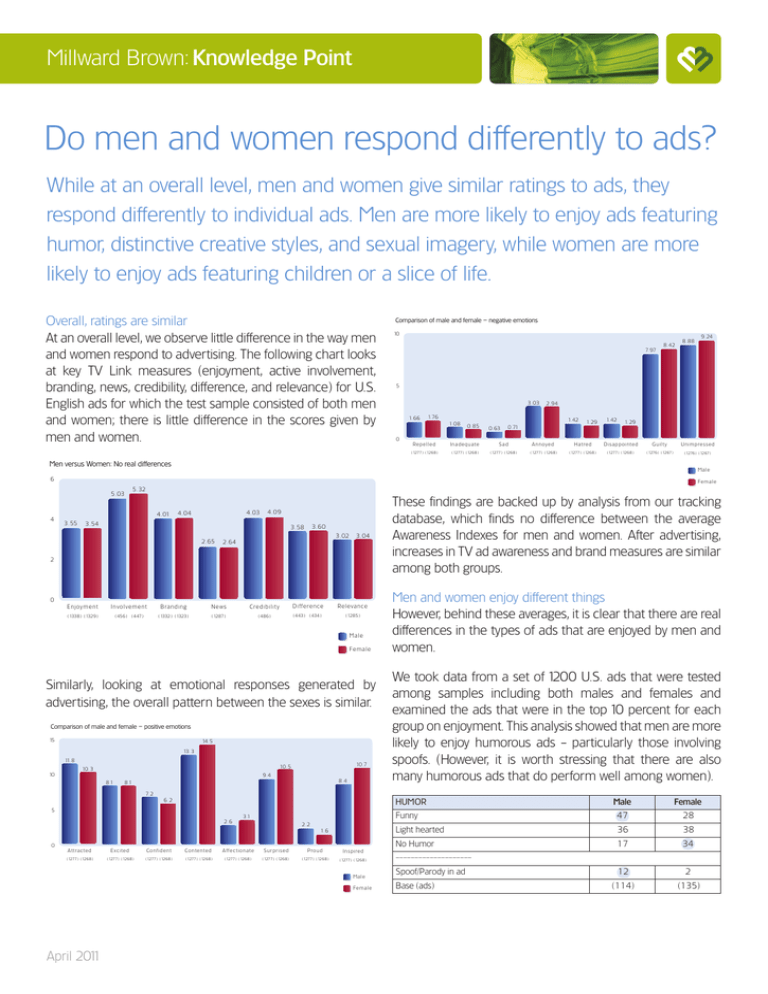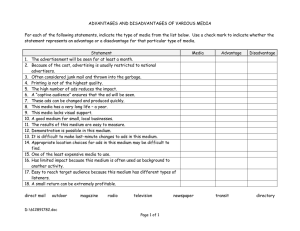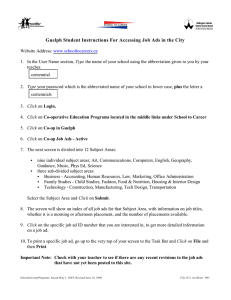Do men and women respond differently to ads? - ARMI
advertisement

Millward Brown: Knowledge Point Do men and women respond differently to ads? While at an overall level, men and women give similar ratings to ads, they respond differently to individual ads. Men are more likely to enjoy ads featuring humor, distinctive creative styles, and sexual imagery, while women are more likely to enjoy ads featuring children or a slice of life. Overall, ratings are similar At an overall level, we observe little difference in the way men and women respond to advertising. The following chart looks at key TV Link measures (enjoyment, active involvement, branding, news, credibility, difference, and relevance) for U.S. English ads for which the test sample consisted of both men and women; there is little difference in the scores given by men and women. Comparison of male and female – negative emotions 10 7.97 8 .42 5 3.03 1.66 1.08 0 2.94 1.76 1.42 0.85 0.63 0.71 1.29 1.42 1.29 Repel led Inadequate Sad Annoyed Hat red Dis appointed Guilty Unimpressed (1277 ) (1268 ) (1277 ) (1268 ) (1277 ) (1268 ) (1277 ) (1268 ) (1277 ) (1268 ) (1277 ) (1268 ) (1276 ) ( 1267) ( 1276) ( 1267) Men versus Women: No real differences Male 6 Female 5. 03 4 5. 32 4.01 3.55 4.03 4.04 4.09 3.54 3.60 3.58 2.65 3. 02 3.04 2.64 2 0 Enjoyme nt I nvo lve me nt Bran d in g News Cre d ib il ity Diffe re n c e Rel eva nce (1338) (1329) (456) (447) (1332) ( 1323) ( 1287) ( 486) ( 443) ( 434) (1285 ) Ma l e Fema l e Similarly, looking at emotional responses generated by advertising, the overall pattern between the sexes is similar. Comparison of male and female – positive emotions 15 14.5 13.3 11. 8 10.7 10.5 10. 3 10 9.4 8 .1 8.4 8 .1 These findings are backed up by analysis from our tracking database, which finds no difference between the average Awareness Indexes for men and women. After advertising, increases in TV ad awareness and brand measures are similar among both groups. Men and women enjoy different things However, behind these averages, it is clear that there are real differences in the types of ads that are enjoyed by men and women. We took data from a set of 1200 U.S. ads that were tested among samples including both males and females and examined the ads that were in the top 10 percent for each group on enjoyment. This analysis showed that men are more likely to enjoy humorous ads - particularly those involving spoofs. (However, it is worth stressing that there are also many humorous ads that do perform well among women). 7. 2 Male Female Funny 47 28 Light hearted 36 38 No Humor 17 34 HUMOR 6.2 5 2.6 3.1 2.2 1.6 0 9. 24 8 .88 Att ra c te d Exc i te d Co n fi d ent Contented Affec tionate Sur prised Proud Ins pired ( 1277 ) ( 1268) (1277) (1268) (1277) (1268) (1277) (1268) (1277) (1268) (1277) (1268) (1277) (1268) (1277 ) (1268 ) Male Fem ale -------------------Spoof/Parody in ad Base (ads) Base April 2011 12 2 (114) (135) 2 Millward Brown: Knowledge Point A Spanish ad that features a humorous scene in a slaughterhouse provides an example of humor that appeals more to men than women. Men better appreciated the intended black humor; it kept their attention. However, the somewhat violent nature of the ad put off the female target, who did not enjoy the ad. Other ads may actually alienate women. For example, one German ad for a chocolate brand targeted at young adults featured a teacher behaving in an erotic, flirtatious manner in front of her young adult class. Responses to the ad differed substantially by gender. Men enjoyed the woman’s behavior, while women increasingly lost interest as the ad progressed. The ad fails to engage women German Chocolate ad AUDIO Woman enters She A grade the room translates and starts words of school 30 a lesson with young MORE adults INTERESTING 20 Female legs on high-heels going in 10 a hall VISUAL MORE INTERESTING Product demo Product usage Romantic scenery Scale: Standard Scale: Standard 30 SECS 21.5 SECS Packshot & Slogan MORE BORING Male Female Cut & Change of scene: in the slaughtery Woman comes again to the fore. She licks off some crème from her finger Woman takes as well a piece and eats it with indulgence Product described, woman only in the background Product shot and slogan 0 0 1 -10 MORE BORING Man eats a piece of the product -20 2 3 4 5 6 7 8 9 10 11 12 13 14 15 16 17 18 19 20 21 22 23 24 25 26 27 28 29 Product description Zoom onto the woman’s face and further on the mouth -30 Base: Total Male (50) Female (50) VISUAL While men enjoy a distinctive creative style, women on the whole are more likely to enjoy ads featuring a slice of life, or children. There was no significant difference in messaging style between the most enjoyed ads for each group. Male Female Distinctive creative style 36 22 Slice of life 32 47 Children 9 36 Emotional 41 50 Rational 16 14 Both 37 33 (114) (135) Base (ads) Response to sexual imagery Ads that feature sexual imagery can also elicit distinctly different responses from the two sexes. Some ads are enjoyed by both sexes, but for different reasons. For example, a deodorant ad featured a girl preparing for a date while her boyfriend is coming up in the lift. It was an entertaining ad that performed well overall, but men and women found different parts interesting. Women followed the main elements of the story, while men showed peaks of interest only when the woman appeared in her underwear. ©2011 Millward Brown More than twice as many men as women said they would enjoy watching the ad (52 percent versus 24 percent). Over half of the men liked the woman in the ad while only 14 percent of women did. Almost a quarter of the women disliked the ad for being sexist or erotic. Given that women were an equal target for the brand, this represented a major problem. So while at an overall level there may be no differences in responses to advertising between the sexes, there are clearly differences in response to individual ads. Knowledge Points are drawn from the Millward Brown Knowledge Bank, consisting of our databases of 132,000 brand reports and 70,000 ads, as well as 1,400 case studies, 900 conference papers and magazine articles, and 350 learnings documents. Share this Knowledge Point:



